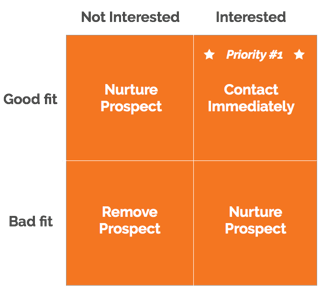


So you've nailed inbound lead generation? Now what?




UPDATE: As with everything we do, our sales process is a continually eveolving beast. And by beast we mean "beautiful symposium of fluid actions ending in sales glory"... We've expanded on what we do, namely adding in a proposal pitch stage. Our intention on expanding the process out is to actually shorten our sales process and ensure client buy in before we finalise the proposal and latter stages of the sales cycle.
Leads, leads, leads... For most of our clients, inbound lead generation is the dream and the ultimate end point. It's why they approach us, an inbound marketing agency.
"Rich, I want more leads. If I get more leads, I'll grow my business."
Well yes, that's true, in part. But it's not exactly the last piece of the puzzle, is it?
What happens to those leads? Who gets them? What do they do with them? Is there a process all your leads go through? How do you communicate all the amazingness you can potentially do for your clients after they've initially jumped headlong into your funnel?
We're an inbound marketing agency, so unsurprisingly, we favour inbound lead generation. We learn about the prospect, what they do, what they're trying to achieve and who they are. We're helpful in our approach and importantly, we use the sales process to qualify our leads as good fit clients.
Finding clients that are a good match is important to us (it's part of our core values). A good match means a good relationship, which means good value for the client. If we're not the right agency for you, then you won't get the value you need from us. We don't want to waste your time if we're unable to help you.
The inbound sales approach
Inbound isn't always a good fit either. It takes time and investment, so we work hard to qualify our own leads. We believe the sales process is the best time to do that.
An inbound sales approach will differ for everyone. Ours has been built on a basis of trial and error. We've learned what works for us (and a lot about what doesn't) and we use the assets we have available to us.
So, without wanting to ruin the magic if you ever end up in our sales funnel, this is our "
(Just before we start... This is our "ideal" sales process. Sometimes we bounce around this process, chop and change, wiggle and move. But it gives you a pretty good outline of where we would like it to be.)
1. Get 'em in
Social, search, biddable, referral, outreach, magic and witchcraft – however you find us, somehow you have ended up as a lead in our marketing and sales funnel. You may have signed up to our newsletter, you may have downloaded a guide, perused a case study, clicked through on a social ad... somehow, we've got your email address (at the very least).
2. Be helpful
As soon as you touch our website, we start offering our help. At the top of our funnel, our content isn't "
Looking at what channels you've come from, which content you're reading and how you're spending time on our site, we start to make some assumptions about what it is you're looking for.
For example, if you're on our website reading blogs about
Inbound marketing is built around personas, and we use trigger points (or some straight, up-front questions) to figure out which persona you fall into. If you're looking for information about lead generation, its likely you are someone in a senior sales role within your business. At the very least, you have a vested interest in sales activity. Now, we can start to guess which persona you fit within.
Our site personalises and adapts around these assumptions.
3. Naughty by nurture
So now we know who you are, which channels you landed in our funnel from, and also the kinds of content you're interested in. It's highly likely we have more content just like that, possibly even a guide or worksheet to help you with the topic... So, we're going to nurture you over email and social media, and present you with that very content. We're simply reminding you that we exist, and can actually be quite helpful.
While this is all going on, in the background, we have our marketing automation sizing you up. We're scoring you, making assumptions as to whether your intent and client fit are at the point where we should give you a call. HubSpot

With inbound lead generation, one of the things that can really hamper a campaign's success is whether you're putting the right leads in front of the people calling them. Wrong (or bad fit) leads equate to wasted time. Through nurturing, we can qualify and warm prospects to ensure that they're ready for a call and we're ready to sell.
We base our lead scoring on a lot of factors, but some key ones are below:
- Did their email bounce?
- Is their phone number valid?
- How much and which contact information have they shared?
- Which channel did they come from?
- How much and what type of activity have they had on our site?
- Have they interacted with key pages? (e.g. a pricing or case study page)
- Have they interacted with us over social media?
- Is their company already on our "hot prospects" list?
4. We connect on a call
So, you've topped out over our lead scoring threshold... now we call you.
This isn't a pitch call. It's not a presentation. It's a connection. We call you to introduce ourselves, to qualify you further, and to find out what it is you're looking for.
We've probably had a chance to look at your site by this point. We may even have a couple of quick wins we can suggest. But again, it's still about being helpful.
This call is normally under 15 minutes - the goal for us here is to build rapport, find out who you are and what you need help with, qualify you with questions and homework, and get the next call in the diary.
A quick caveat on this - sometimes, we jump over the lead scoring bit. If we see a lead that we think is a good fit, we'll jump straight on it.
5. Homework for you
It sounds stupid. You're a potential client, we've just met, but I'm asking you to do stuff before we'll even work with you. However, t
The first and most important reason is because we need to know a lot of key information before our next call. It gives us a basis to ask the right questions and see areas where there might be room for improvement. It very quickly gives us a glimpse into how your company works and what you're trying to achieve.
Our entire

The second reason is that it shows a real investment from you as a potential client. You're investing your time and effort to complete the "homework," which indicates how you might work with us moving forward. Good inbound marketing requires a client's input.
The sorts of things we ask about are:
- What are your USPs?
- Who are your closest competitors?
- What sets you apart from those competitors?
- What does your ideal customer decision maker look like?
- What previous marketing activity have you tried?
6. The exploration [call]
So, now we know a fair bit about you and your company. We think we can offer real value to you and believe you're a good fit for us. It's time for our next call.
This is much more of a "deep dive." We ask all sorts of questions about your company, your competitors, your challenges and we'll even start to [try] get you excited about how we might be able to impact
The whole point of this call
The better this call goes, the better the chances of our proposed conversion rates. It makes sense if you think about it. If we know more, what we propose is far more likely to suit your needs.
7. More nurturing
Now we move back into nurturing. We like to send prospects
For example, imagine you own an art gallery, and you're trying to generate and drive footfall. It just so happens, we have a blog on that... This is sent to you, not to show off, but so you can see we know how to think about your market.
It's also a way of us keeping ourselves front and centre in your mind while we move towards a proposal.
8. We set expectations
The final call before we send over a proposal is the goal setting call. This is a fairly new addition to our inbound sales process.
Historically, the exploratory call was where we would discuss goals and set expectations. The problem we found was that digging into the details of the business, exciting the prospect what we might be able to do, and weighing in with the goals and expectations, all in one call, was either rushed or didn't go in-depth enough.
Splitting the calls also gave us a chance to discuss goals as a team internally. We get a better understanding of what we can do, and a bit of time to think about it.
So, the purpose of this call is to make sure we're all singing from the same hymn sheet. We recap all of the previous stages, flesh out targets and goals, and "low ball" the numbers (we'd rather surprise and delight than risk disappointing.)
We also explain the processes moving forward.
9. Workshop
Depending on what happens with the goal-setting call, we might suggest a goal-setting workshop. If we feel we need to work through some processes and get more detail from you, a workshop is a great way to do it. The best bit? You get to try us before you sign up to a year-long retainer.
We do this a lot with our more technical retainers - integrations which have a lot of moving parts, sectors with nuances or products not easily understood. In reality though, we're now moving all new business towards workshops.
It gives a new campaign the absolute best chance of success. Our teams get to meet and work together and it ensures we're all on the same page. I highly, highly recommend workshops as part of the sales process.
9. We present our initial proposal
Once we have all the insight, facts and stats we need, we'll internally build out the initial strategy and then present this back to you either face to face or over a remote video call. This is like a "proposal light". It doesn't have the depth of a full proposal but gives an outline of budgets, process and ideas. Once we know you're on board and want to progress, we'll start building out the full proposal.
10. If it's love, we'll propose
The last(ish) step in our inbound sales process is the actual proposal. Thankfully, with everything that's gone before, the calls, the workshops, the internal meetings... this pretty much writes itself.
We also won't send out a proposal until we're pretty confident we're going to win the work. If you're a good fit and we've brought you through the entirety of our sales process, you're as invested in us as much as we are in you, and that's great.
If we're not confident, we'll keep nurturing you first.
Jeez, inbound lead generation seems like a lot of work...
Well it is, and it's designed to be. Once you move from prospect to client, from sales to delivery, we know everything we could possibly need to know. We've set reasonable expectations and you've had great insight into how we work as an agency.
This process works for us too, as the cost to have us partnering with you to deliver your marketing is high. These are big ticket sales, so they are worth the investment in time for both you as the prospect and us as an agency. We've effectively been dating for the last 60 days (that's the average of our sales cycle by the way).

I am by no means suggesting that this process works in every scenario, but for us it functions pretty darn well. What I will say, though, is that this process creates relationships with clients that give a basis for great work together.
Brands that perfect their inbound lead generation strategy see falling marketing costs, better quality leads, greater client engagement and other benefits that outbound methods simply can’t provide. Read our blog “Everything you need to know about Inbound lead generation” to learn more.








